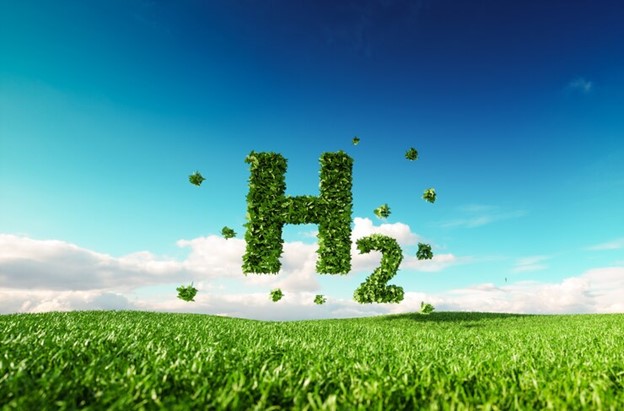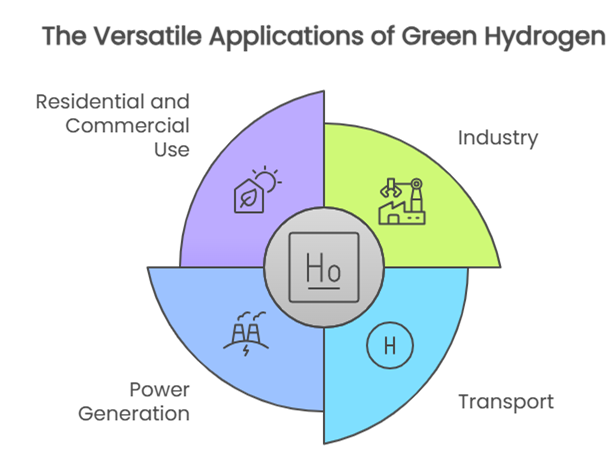Green Hydrogen Uses: Transforming Industry, Transport, and More
Green hydrogen is a clean fuel made from wind, solar, or other renewable energy sources. It does not release harmful gases, so it helps reduce pollution and slow climate change. As more countries aim for net-zero emissions, green hydrogen is becoming the main solution. The world has already spent 600 billion dollars on hydrogen projects[1].
This article discusses green hydrogen uses and how it is transforming industries, transport, and many other important areas in today’s world.

Green Hydrogen in Industry
The production of green hydrogen is done through electrolysis, a process that splits water into two particles: hydrogen and oxygen. Since this process does not involve fossil fuels, it creates hydrogen without releasing harmful carbon gases. Because of this, green hydrogen uses are growing in industries that need a lot of energy, such as steelmaking and chemical manufacturing.
In the steel industry, green hydrogen can replace coal in high-temperature processes. In chemical plants, it works both as a clean fuel and a raw material. Oil refineries also use it to remove unwanted elements from fuels in a cleaner way. These examples are proof that green hydrogen uses are helping to improve old systems.
Benefits of Reducing Carbon Emissions
Green hydrogen use has many benefits in heavy industry, especially in reducing pollution. Some significant advantages are:
- Replaces carbon-heavy fuels like coal and natural gas with a zero-emission alternative.
- Cuts emissions in difficult-to-decarbonise sectors, such as steel and chemical production.
- Lowers the carbon footprint of large-scale manufacturing processes.
- Helps industries meet strict climate laws and emission limits.
- Reduces greenhouse gases that are the major cause of global warming and extreme weather.
Studies show that keeping global warming under 2℃ could prevent 4.5 million early deaths, 1.4 million hospital visits, and 300 million lost workdays by the end of the century[2]. Green hydrogen plays a very important role in achieving that goal.
Green Hydrogen in Transport
Transport is considered to be one of the largest sources of carbon emissions. Using hydrogen powered transportation provides a cleaner alternative across many modes of transport.
Fuel Cell Electric Vehicles (FCEVs)
Hydrogen fuel cell cars provide faster refueling and longer range than battery vehicles. They perform well in cold weather and suit drivers with long commutes. For heavy-duty transport like buses, trucks, and trains, hydrogen and cars using fuel cells are perfect for long distances and heavy loads.
Shipping
Hydrogen-based fuels like ammonia and methanol are also being tested on ships. A case study on Ro-Ro and Ro-Pax ships, which carry wheeled cargo like trucks and cars, shows that hydrogen can be used in engines or fuel cells[3].
This could reduce emissions during sailing and hoteling at ports with hydrogen in vehicles, helping meet strict environmental rules, one of the upcoming best green hydrogen uses.
Aviation
There is a possibility that in the upcoming years, hydrogen might fuel planes through direct burning or fuel cells. Though still in early testing, it promises cleaner air travel, especially on short routes, which is said to be one of the best green hydrogen uses.

Green Hydrogen Beyond Industry and Transport
Green hydrogen is not limited to factories or hydrogen-powered transportation. It is expanding into energy supplies for homes, businesses, and power systems, providing clean and trustworthy alternatives.
Power Generation and Energy Storage
One of the main green hydrogen uses is to store extra energy from solar and wind. This stored hydrogen can later be used in the form of hydrogen gas or hydrogen fuel cells to balance the power grid or provide backup electricity. It also manages the ups and downs of renewable energy.
Residential and Commercial Use
Green hydrogen uses also include powering homes and buildings through fuel cells that provide electricity, heating, and even cooking support. These systems are quiet, clean, and reduce carbon emissions. As the technology improves, more homes and businesses will start using hydrogen-based energy.

Learn More at Mobility Tech Asia 2025
Mobility Tech Asia 2025 is a major event on clean transport and energy. It will be held in Hong Kong from July 15-17. Experts from around the world will share new ideas in electric vehicles, hydrogen fuel cells, batteries, and charging tech.
Register now to learn how green hydrogen is changing energy and meet the leaders behind the progress.
References
- Green hydrogen – statistics & facts. Available at: https://www.statista.com/topics/7783/green-hydrogen/ (Accessed: 20th, June)
- Reducing Emissions to Lessen Climate Change Would Yield Dramatic Health Benefits by 2030. Available at: https://climate.nasa.gov/news/3134/reducing-emissions-to-lessen-climate-change-would-yield-dramatic-health-benefits-by-2030/ (Accessed: 20th, June)
- The use of hydrogen as alternative fuel for ship propulsion: A case study of full and partial retrofitting of roll-on/roll-off vessels for short distance routes. Available at: https://www.sciencedirect.com/science/article/pii/S0360319923052503 (Accessed: 20th, June)

